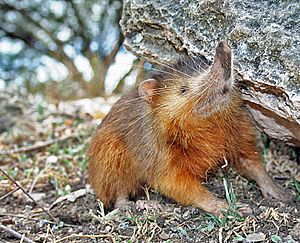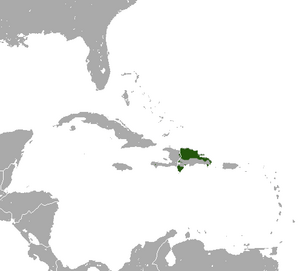Agouta facts for kids
Quick facts for kids Hispaniolan solenodon |
|
|---|---|
 |
|
| Conservation status | |
| Scientific classification | |
| Genus: |
Solenodon
|
| Species: |
paradoxus
|
 |
|
| Hispaniolan solenodon range | |
The Hispaniolan solenodon (Solenodon paradoxus) is a type of solenodon. It is only found on Hispaniola. It is also called the Haitian solenodon, or agouta.
Contents
Description
The Hispaniolan solenodon looks like a shrew. Adults are 49 to 72 cm (19 to 28 in) in length. Its average weight is about 800 g (28 oz). They are usually dusky brown, with a paler underside and reddish fur on the sides of the head, throat and upper chest. The tail, legs, snout, and eyelids are do not have any hair.
Distribution and Habitat
Hispaniolan solenodon is only found on the Hispaniola. Their habitat is usually found in moist forests that are not disturbed by human activities. They are usually found below an altitude of 1,000 m (3,300 ft). They are sometimes found at higher altitudes or near developed agricultural land.
Feeding
Hispaniolan solenodons mainly eats arthropods. It also eats worms, snails, mice and small reptiles. It may also eat a small amount of fruit, grains, and leaf litter.
Behaviour
Hispaniolan solenodons are nocturnal. During the day, they stay in their burrows, in trees, caves, or hide. Their burrows may have lots of chambers and tunnels. Adult male and female usually live together with six young ones.
Reproduction
It breeds throughout the year. It has a gestation period of over 84 days. It gives birth to one to three young ones. Usually, if it gives birth to three only two will survive, because the female only has two teats. The young ones are born blind with no hair. The young ones weigh 40 to 55 g (1.4 to 1.9 oz). For two months, they are carried around by the mother. No one knows how long it takes for them to be weaned. They can live for over eleven years in captivity.
Conservation status
The Hispaniolan solenodon is an endangered species because of habitat loss and predation by introduced species. Its numbers have decreased during the last few decades.
The species is protected by law. However, national parks in both Haiti and the Dominican Republic are threatened by deforestation, using the land for farming and charcoal production. The US Agency for International Development and the Nature Conservancy are working with local nongovernmental organisations to make the protection for these parks better.
Images for kids
See also
 In Spanish: Solenodonte dominicano para niños
In Spanish: Solenodonte dominicano para niños




